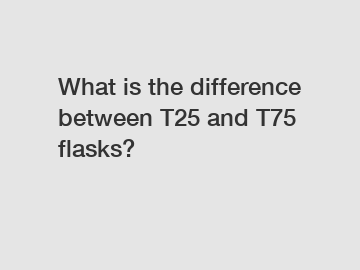What is the difference between T25 and T75 flasks?
What is the difference between T25 and T75 flasks?
Tissue culture plays a crucial role in various scientific disciplines, such as biology, medicine, and biotechnology. Tissue culture flasks are a fundamental component of this process, providing the right environment for the growth and propagation of cells. Among the different types of tissue culture flasks available, T25 and T75 flasks are the most commonly used. But what exactly sets them apart? In this article, we will delve into the key differences between T25 and T75 flasks, exploring their sizes, cell capacity, and applications.
1. Flask Sizes:

The primary distinction between T25 and T75 flasks lies in their sizes. The number associated with each flask type represents the surface area (in square centimeters) available for cell growth. A T25 flask offers a surface area of approximately 25 cm², while a T75 flask provides about 75 cm², making it noticeably larger. The significance of this difference shouldn't be underestimated, as it directly affects the total number of cells that can be cultured in each flask.
2. Cell Capacity:
Due to their varying sizes, T25 and T75 flasks differ in terms of the number of cells they can accommodate. A T25 flask typically holds a smaller number of cells, ranging from 1 to 2 million cells, depending on the cell type. On the other hand, a T75 flask can accommodate a significantly higher quantity, ranging from 4 to 7 million cells. Therefore, researchers often choose the flask type depending on the desired scale of cell propagation.
3. Application:
The different sizes and cell capacities of T25 and T75 flasks also make them suitable for distinct applications. T25 flasks are commonly used during the initial stages of cell culture, particularly when researchers need to establish cell lines or conduct small-scale experiments. They are also employed in experiments where low cell density is required. Conversely, T75 flasks are more suitable for large-scale experiments, including the production of a high number of cells for downstream applications or for when higher cell density is essential.
4. Medium Volume:
Another factor to consider when choosing between T25 and T75 flasks is the volume of culture medium required. T25 flasks hold a smaller volume, usually around 15-25 ml. In contrast, T75 flasks can accommodate a higher volume, usually ranging from 60 to 75 ml. This difference in medium volume is correlated with the size of the flask and the number of cells to be cultured, as larger cultures require more nutrients and space for optimal growth.
In conclusion, understanding the difference between T25 and T75 flasks is crucial for researchers engaging in tissue culture experiments. T25 flasks offer a smaller surface area, suitable for small-scale experiments and low cell density studies. On the other hand, T75 flasks provide a larger surface area and higher capacity, enabling larger-scale experiments and high cell density cultures. By selecting the appropriate flask type, researchers can optimize cell growth, maximize efficiency, and ensure a successful tissue culture process. So next time you find yourself in the lab, question the difference between T25 and T75 flasks – the answer might just be the key to unlocking a cellular breakthrough!
Want more information on cell factory system, cell culture roller bottle supplier, flake microcarrier? Feel free to contact us.

Comments
0